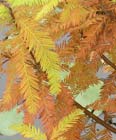
Foliage on a tree at the North Carolina Botanical Garden, Chapel Hill, NC [C.J. Earle, 2004.10].
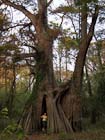
The big tree at Cat Island, Louisiana [©Vladimir Dinets 2012].
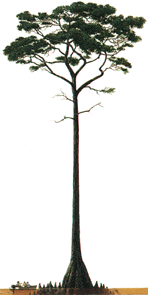
Representative painting of an old-growth tree on the floodplain at Congaree Swamp National Park, SC (National Park Service 1995).
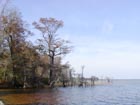
A shoreline stand at Lake Waccamaw State Park, North Carolina [C.J. Earle, 2003.11.26].
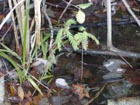
Seedlings at Lake Waccamaw State Park, North Carolina [C.J. Earle, 2003.11.26].
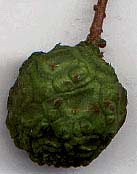
Immature female cone from a tree at the Sacramento Capitol Arboretum [C.J. Earle].

Conservation Status

Taxodium distichum var. distichum
Common names
Bald-cypress, southern-cypress (Watson 1993).
Taxonomic notes
Synonymy:
- Cupressus disticha L. 1753;
- Cupressus laeta Salisb. 1796;
- Schubertia disticha (L.) Mirb. 1825;
- Cuprespinnata disticha (L.) J. Nelson 1866;
- Cupressus disticha L. var. patens Aiton 1789;
- Taxodium distichum (L.) Rich. var. patens (Aiton) Sweet 1827;
- Taxodium sinense J. Forbes var. pendulum J. Forbes 1839;
- Glyptostrobus pendulus (J. Forbes) Endl. 1847;
- Taxodium distichum (L.) Rich var. pendulum (J. Forbes) Carr. 1867;
- Taxodium sinense Nois. ex Gordon 1858 non J. Forbes 1839;
- Taxodium distichum (L.) Rich. var. nutans Carr. 1867 non Sweet 1827.
Description
Trees to 50 m tall and 400 cm dbh. "Bark usually dark reddish brown to light brown with shallow furrows. Branchlets mostly with leaves in 2 ranks, pendent to horizontally spreading. Leaves mostly narrowly linear, ca. 5-17 mm, laterally divergent, free portion contracted and twisted basally. 2n= 22 (Watson 1993).
Distribution and Ecology
USA: Alabama, Arkansas, Delaware, Florida, Georgia, Illinois, Indiana, Kentucky, Louisiana, Maryland, Missouri, Mississippi, North Carolina, Oklahoma, South Carolina, Tennessee, Texas, and Virginia at 0-500 m elevation in brownwater rivers, lake margins, and swamps, occasionally in slightly brackish water (Watson 1993).
This variety has not been assessed by the IUCN and thus has no formal conservation status. Per IUCN criteria, it would likely be assessed as "Least Concern" which is the ranking assigned to T. distichum.
Remarkable Specimens
The official "big tree" has a dbh of 521 cm, height of 25 m and crown spread of 26 m, located on Cat Island, Louisiana (American Forests 2000). The tallest known specimen is in Carter's Grove, Williamsburg, Virginia; it is 44.11 m tall (Rucker 2003).
In 2019, specimen BLK227 was announced to have crossdated age of 2,624 years. Only four species are known to attain greater ages (see How Old Is That Tree?). This specimen was collected near the Black River, North Carolina, within a preserve owned by The Nature Conservancy. Ancient trees also occur outside the preserve, but are currently threatened by logging and water quality concerns (Stahle et al. 2019). The Black River area has long been recognized as hosting extraordinarily old trees; the former age record for this species was a crossdated age of 1,622 years for specimen BCK69 from the Black River, collected by Stahle, Cleaveland, and Hehr (Brown 1996). The 1,622 year-old-collection was made in the 1980's, and I visited it in 1987. The tree is in an area that has seen many hurricanes and all trees in the area have lost their tops repeatedly; as a consequence, the tree is hollow. It would be hard to estimate a total age for the tree, but it must certainly exceed 2,000 years and possibly 3,000.
Ethnobotany
Observations
Remarks
Citations
American Forests 2000. The National Register of Big Trees 2000. Washington, DC: American Forests.
Stahle, D. W., J. R. Edmondson, I. M. Howard, C. R. Robbins, R. D. Griffin, A. Carl, C. B. Hall, D. K. Stahle, and M. C. A. Torbenson. 2019. Longevity, climate sensitivity, and conservation status of wetland trees at Black River, North Carolina. Environmental Research Communications 1:041002.
See also
Farjon (2005).






